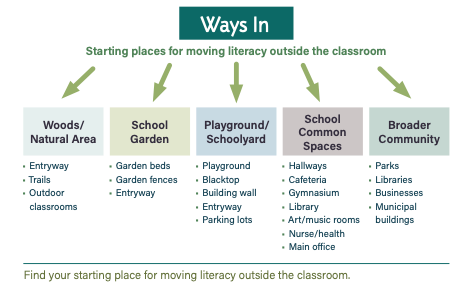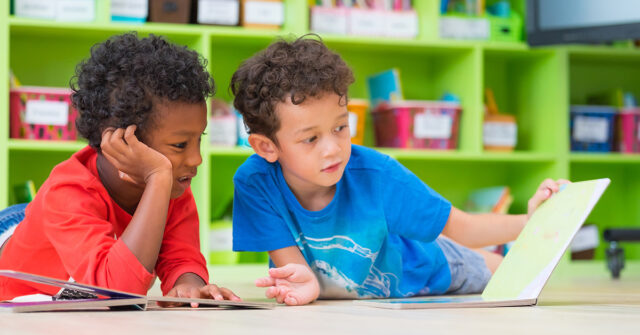
The following is adapted from Literacy Moves Outdoors: Learning Approaches for Any Environment by Valerie Bang-Jensen.
If you’re wondering what literacy might look like outside the classroom, it’s everywhere. The first word a young child may learn to read is STOP, a useful directive encountered at crosswalks and streets everywhere. Supermarkets use signage to direct us to items on our shopping lists, and once we find them other signs identify the product and price. At the local museum, a docent engages a gathered group with snippets of history stories bulleted on her clipboard. We may encounter poetry chalked on sidewalks or stapled among advertisements on the bulletin board of a local convenience store. Pages of a gorgeous picture book are posted to entice hikers on a story walk up a hill through the woods, alerting them along the path to the way that different birds build their nests. Literacy can be everywhere; reading and writing outside the classroom enables us to appreciate and connect to our broader community and world. These experiences also offer young writers power and agency in considering audience for literacy in authentic settings.
Why Move Literacy Outdoors?
If there has been a silver lining of any kind to the pandemic, it’s that social distancing compelled many teachers to think nimbly, and this meant that when they could, they moved their classes outdoors. A tough challenge at first, but once new routines were established and curricular adaptations made—think sensory paths, nature journals, and phonics treasure hunts—teachers discovered unanticipated benefits. During a recent focus group discussion, anecdotes poured in. Third-grade teacher Abbie noticed that everyone is calm and more settled back in the classroom after being outside for a lesson. Special educator Kristin observed that her students are better able to focus on learning when she balances outdoor and indoor experiences. And Caitlin, an upper-elementary science teacher, described how twice-weekly nature journal writing has been transformative for her students; their ability to make specific observations is transferring into all of their writing.
Outdoors is the New Classroom
My thinking about literacy outdoors pays homage to powerful thinking about outdoor learning, learning about nature, and ways of being outside with children. Recent leaders in the field, like Richard Louv, David Sobel, Juliet Robertson, Herb Broda, and others, have provided compelling arguments about the value of getting children outside. Louv (2008, 7) writes that nature demands “. . . the full use of the senses.” Being outdoors invites us to notice in new ways, to be affected by sound, smell, and tactile experiences that are part of our world yet are different from those available indoors. Juliet Robertson (2014, 2) observes that “outdoor learning is an umbrella term which covers every type of learning experience which happens outdoors,” including playground games, environmental education, and “adventurous activities.” She notes that being outdoors is a key part of physical development, requiring navigation of territory and problem-solving. Much of the current focus is on nature-based education, and the proliferation of Forest Kindergartens, outdoor classrooms, nature centers, and nature-oriented summer programs reflects this. In his accessible and thorough book, Schoolyard-Enhanced Learning: Using the Outdoors as an Instructional Tool, K–8, Broda (2007, 20) notes that “language arts concepts seem more immediate and compelling when you are trying to share what you have experienced in the environment.” You will find that many of the ideas in Literacy Moves Outdoors lean heavily on nature-oriented outdoor learning, but this is not my focus. I invite you specifically and enthusiastically to move literacy outdoors wherever you are.
Finding Ways Into Outdoor Literacy Learning
For many students, literacy means the reading and writing they do in the classroom, yet reading and writing happen everywhere we go. Purpose, audience, and place are compelling reasons to shape writing and reading when literacy moves out of the classroom and into real world settings, both natural and engineered. Your school setting will shape the ways that you might implement the approaches in this book, and I have made suggestions along the way for rural, suburban, and urban schools. You will also find some beginning guidelines related to universal design. These include efforts to make learning experiences accessible to all students, enabling them to be independent and participate in a variety of ways. You’ll want to consider space, safety, and strategies to support a wide range of literacy and language skills. Specific and expanded guidelines, plus 7 principles may be found on the website for the Centre for Excellence in Universal Design.
Ways in for Varied Settings
There are multiple ways to create experiences outside the classroom that invite students to make discoveries about literacy, particularly about purpose and audience. In Literacy Moves Outdoors, you will find a continuum for different levels of investment in terms of your time and materials. You might be ready to dip your toe into literacy outdoors on a beautiful day with the “literacy to go” backpacks. If you’re ready to reshape a whole curricular unit on writing to inform, the chapter on signage might work for you as your starting point. A StoryWalk© might be the perfect way to have a celebration of your poetry unit.
We can use literacy to weave learning together and to build strong school communities. While classrooms are separate and discrete spaces, the outdoors belongs to everyone—a shared space for everyone in the whole school to explore and gather. Outdoor learning initiatives can lead to shared inquiries, problem-solving, and celebration, supporting literacy learning all the while.

In Literacy Moves Outdoors you will find five broad approaches to literacy that you can move outdoors: Literacy to Go, Word Gardens, StoryWalks©, Interpretive Signage, and Literacy Trails. You will find first steps, varied entry points, logistics, literacy connections, and ways that you can level up once you’re ready, organized in a way to help maximize learning and connect what you teach inside with what you do outside. All these approaches incorporate excellent children’s books—relevant beginning lists of both fiction and nonfiction titles are offered, and I am sure you’ll add some of your favorites as you try things out. The various approaches offer a chance to experience different aspects of literacy, but you will find some common elements. All of them use visual literacy to communicate meaning, and encourage student writers to consider audience needs and the relationship of the text to the setting. And each approach invites you to discover platforms for literacy learning that are authentic to specific settings, and offers resources for launching projects.
Find your way in and start moving literacy outdoors!
Download a sample and discover practical strategies and experiences for supporting literacy development outside of the traditional classroom environment, as well as varied entry points, logistics for implementation, literacy connections, resources, and relevant book lists.

Valerie Bang-Jensen is Professor of Education at Saint Michael's College, where she has earned the college’s Rathgeb Teaching Award. She received her A.B. at Smith College and MA, M.Ed., and Ed.D. degrees from Teachers College, Columbia University. Valerie has taught in K-6 classrooms and library programs in public and independent schools in the U.S. and Paris, and was the district elementary writing coordinator in Ithaca, New York. She serves as a consultant for museums, libraries, schools and gardens for children. Valerie's areas of interest include children's literature, nonfiction, and connections between literacy and first-hand experiences. Valerie co-founded the Teaching Gardens of Saint Michael’s College, including one called Books in Bloom, which features flowers found in children’s books. Valerie can be found on Twitter at @VBangJensen.



